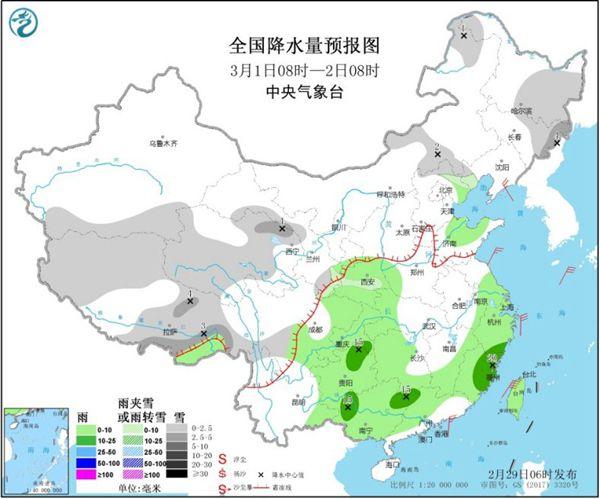China Weather Network News predicts that there will be light to moderate snow or sleet in some parts of the Northeast, North China and other places today and tomorrow (February 29-March 1); there will still be a large range of rain in the south Weather, and be alert to foggy weather that can easily occur after rainfall. In terms of temperature, it is expected that in early March, China will still be frequently affected by cold air. Temperatures in most northern regions fluctuate significantly, while those in the south are weak.
Starting yesterday, rain and snow in the north shrank to the east, and rain areas in the south continued to move south. Monitoring shows that yesterday there was light to moderate snow or sleet in northeastern Inner Mongolia, central and southern Heilongjiang, central and eastern Jilin, northern Liaoning and northern Xinjiang, and heavy snow in parts of southern Heilongjiang and northeastern Jilin (5 to 8.1 mm). In addition, moderate rain and local heavy rain occurred in eastern Yunnan, eastern and southern Guizhou, and the middle and lower reaches of the Yangtze River.
Today, it is expected that there will be weak rain and snow in some areas of Beijing, Tianjin, Hebei, and passing by in a hurry; snowfall in the northeast area will become scattered; and most of the south of the Yangtze River will continue to rain. The Central Meteorological Observatory predicts that there will be light to moderate snow or sleet in parts of southwestern Xinjiang, western Tibet, western Gansu, eastern Inner Mongolia, northern North China, most of Liaoning, and central and eastern Heilongjiang on February 29; There was light to moderate rain in most parts of Jiangnan, northern South China, and Taiwan Island. Among them, heavy rain and local heavy rain (50-80 mm) occurred in parts of eastern Guizhou, southern Hunan, and central Jiangxi.
In the beginning of March, cold air still affects China, and a new round of rainfall will start in the south. The Central Meteorological Observatory predicts that there will be light to moderate snow or sleet in parts of most of Tibet, eastern and southern Qinghai, western Gansu, northern North China, and eastern Northeast China on March 1.
In terms of temperature, due to the influence of frequent cold air, the temperature fluctuations in most northern regions will be obvious in the coming week. In areas such as Northeast China, East Northwest China, and North China, where the temperature is currently relatively high, the temperature will drop significantly from March 1 and turn to low for 3-4 days.
The temperature drop in North China will come a little later. From March 3rd to 4th, the temperature will turn to a low level, which will last for about 2 days. Like Taiyuan, today's maximum temperature will reach 16 ℃, or it will reach a new high this year. The average level of Taiyuan in the same period of the year is only 7.4 ℃. By 3 days, the maximum temperature will drop to only 6 ℃. .
In the south, the next week will be affected by the continuous rain and rain, the temperature will be weak, and the feeling of dampness will be very significant. In addition, the low temperature and rainy weather will bring adverse effects on agricultural production, reminding farmers in the south to adjust the sowing and transplanting time according to the weather forecast in time to avoid low temperature rainy days.

